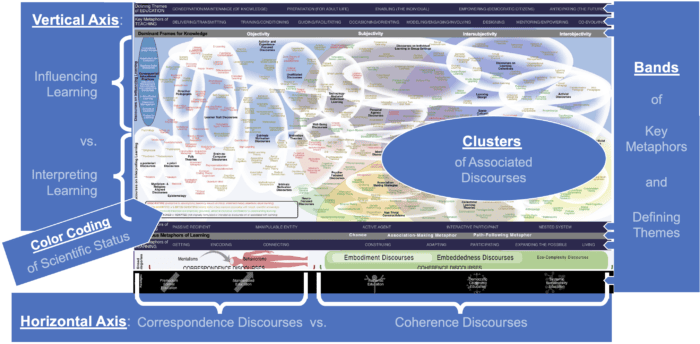Reading the Map
The map “locates” major discourses on learning in relation to one another. (See the Comprehensive Index for listings and locations of subdiscourses.) Five devices are used to highlight convergences and divergences, as indicated on the following image and as described below. As well, a brief “video tour” of these features is included at the bottom of this page.

One sharp and vital distinction arises across the hundreds of discourses on learning that are reviewed on this site: Each discourse can be classified as either a Correspondence Discourse or a Coherence Discourse.
A Correspondence Discourse assumes a separation of the physical and the mental, and thus describes learning in terms of a correspondence between what’s happening in physical reality and what’s happening in one’s mental world. Correspondence discourses that focus mainly on one’s internal, subjective world are known as Mentalisms, and those that focus on external, observable actions are known as Behaviorisms.
A Coherence Discourse approaches learning in more systemic terms, in which the learner is understood as an agent that is part of a grander dynamic system. Learning is seen as a continuous process of co-evolution. We have classified coherence theories according to their levels of focus. Embodiment Discourses encompass those that are concerned mainly with individual learning. Embeddedness Discourses comprise those that are principally concerned with collective (social and cultural) dynamics. Eco-Complexity Discourses generally address more-than-human matters.
Discourses on learning in education tend can be characterized according to two broad purposes: interpreting learning and influencing learning. Discourses on interpreting learning address what learning is – that is, they offer definitions and descriptions of its aspects, dynamics, and consequences. Discourses on influencing learning tend to be pragmatic. They are typically more concerned with characterizing learners and prompting change. That is, they generally address matters that are associated with pedagogy – including, for example, considerations of the sorts of traits, experiences, technologies, contexts, and relationships that likely affect learning.
As we shifted from summarizing discourses to populating our map, thematic clusters began to emerge. Many, many clusters could be identified, but we’ve elected to highlight about 30 that seem to have particular currency. These clusters are represented on the map by opaque ellipsoids labeled in bold-faced grey. The ellipsoid will highlight if you scroll over a label, and a description of the cluster’s uniting theme will pop up if you click on the label.
It goes without saying that different discourses on learning describe learning in different ways. For the most part, these differences are evident in metaphors and themes used to characterize learning, learners, teaching, and education. We’ve signalled some of the broad themes in grey bands that stretch horizontally across the map.
It’s important to emphasize that the labels provided in these bands are generalizations. Metaphors and themes that are specific to individual discourses are included in their summaries (and are not always entirely consistent with the generalizations in the bands).
The word scientific does not have a standardized definition. Our working definition on this site is developed around four criteria that are commonly associated with robust inquiry. Specifically, on this site, a discourse is deemed “scientific” if it …
- is explicit about its assumptions (including metaphors and imagery used to describe learning);
- is associated with a body of replicable evidence, none of which flatly contradicts the discourse;
- is open to revision (or rejection) in the face of new evidence or interpretation;
- meshes (preferably, but not necessarily) with other theories that address related matters.
Those discourses on learning that, in our analysis, meet the first three of these criteria have been classified as “scientific” and color-coded in green. That is, based on the information we were able to access, these discourses are robustly theorized and empirically grounded, aimed at innovative contributions to understanding learning. Those discourses that meet none of the first three criteria are classified as “unscientific” and color-coded in red. These discourses are inattentive to assumptions, with tendencies toward uncritical, entailment-heavy assertions about learning. Those discourses that fall short on one or more of the first three criteria are identified as “quasi-scientific” or “limited-scientific” and color-coded in amber. In formal terms, these discourses currently lack some critical element associated with robust, scientific knowledge. We anticipate that these discourses will eventually be classifiable as either scientific or unscientific, as more fine-grained understandings of learning emerge.
